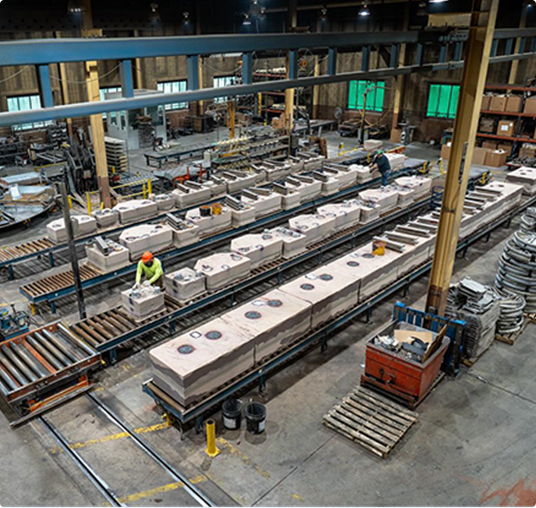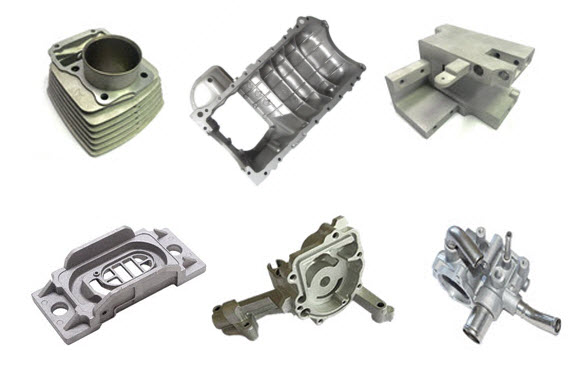Top sectors that rely on Aluminum Castings every day
The Role of Aluminum Casting beforehand Sustainable Production Practices
Aluminum casting works as an essential aspect in advertising sustainable production practices. Its capability to produce top notch components with a minimized environmental footprint is impressive. The process not just sustains energy effectiveness yet also considerably enhances recyclability. Nevertheless, obstacles remain in completely realizing its possibility. Checking out the advancements in aluminum casting technology could expose remedies that straighten manufacturing with sustainability goals. The ramifications of these innovations deserve considering.
Understanding Aluminum Casting and Its Process
Although aluminum casting has actually been a basic procedure in making for decades, its significance remains to grow in different markets because of its convenience and performance. This process involves pouring molten aluminum right into mold and mildews to develop detailed forms and parts, making it excellent for generating light-weight yet sturdy items. The aluminum casting process can be categorized into a number of techniques, including sand casting, die casting, and investment casting, each offering unique benefits matched to certain applications.
During the casting process, aluminum is heated to its melting factor, permitting it to stream quickly into mold and mildews that specify the final form. As soon as cooled down, the aluminum solidifies, causing a solid and exact component. The ability to generate complicated geometries with minimal waste emphasizes aluminum casting's duty in contemporary manufacturing - Aluminum Castings. As sectors seek innovative remedies, comprehending this process comes to be necessary for enhancing manufacturing and fulfilling the demands of an evolving market
Ecological Benefits of Aluminum Casting
As sectors increasingly focus on sustainability, the environmental advantages of aluminum casting end up being more obvious. One significant benefit is the material's recyclability; aluminum can be reused consistently without weakening its high quality. This lowers the amount of waste sent out to landfills and decreases the need for virgin products, conserving natural deposits. Furthermore, the aluminum casting procedure generates less greenhouse gas emissions compared to various other metal casting techniques, adding to lower total environmental effect.
An additional benefit hinges on the light-weight nature of aluminum, which results in sustain efficiency in transportation applications. By using aluminum parts, producers can minimize vehicle weight, leading to lowered fuel consumption and exhausts during procedure. Moreover, developments in aluminum casting innovations have actually led to a reduction in contaminated materials manufacturing, enhancing total ecological safety and security. Jointly, these variables placement aluminum casting as a principal in promoting sustainable manufacturing practices and meeting environmental goals across various industries.
Energy Efficiency in Aluminum Manufacturing
Energy efficiency plays a vital function in aluminum manufacturing, noticeably influencing total sustainability. By taking on ingenious casting methods and integrating renewable resource sources, makers can achieve decreased energy consumption throughout the manufacturing process. This shift not only decreases functional expenses but also adds to an extra eco-friendly industry.

Reduced Energy Usage
While the aluminum manufacturing market has actually commonly been energy-intensive, current advancements have greatly improved energy efficiency throughout the production process. Developments in smelting innovation and the adoption of high-efficiency heating systems have significantly decreased energy usage. These enhancements allow producers to utilize less power per device of result, decreasing greenhouse gas exhausts and decreasing functional expenses. Furthermore, the combination of renewable resource resources right into manufacturing facilities even more contributes to reduced dependence on nonrenewable fuel sources, promoting sustainability. Executing advanced insulation products and maximizing warm recovery systems also plays an essential duty in making best use of power effectiveness. Therefore, the aluminum sector is making considerable strides toward reducing its total environmental footprint while fulfilling the enhancing demand for lasting methods in manufacturing.
Cutting-edge Casting Techniques
Cutting-edge casting methods are transforming the aluminum production landscape, enhancing both performance and sustainability. Advanced techniques such as die casting and financial investment casting reduce material waste and boost dimensional precision, causing minimized power usage throughout the production process. Methods like rapid solidification and semi-solid handling enable better control over metallurgical buildings, leading to light-weight and high-strength elements. In addition, the implementation of computer system simulations and automation in casting processes enhances cycle times and reduces flaw prices. These developments not just improve manufacturing but likewise add to the circular economic climate by making it possible for the recycling of aluminum scrap into high-grade products. As an outcome, the aluminum sector is poised to satisfy expanding needs while adhering to sustainable production techniques.
Renewable Energy Combination
A substantial shift towards renewable resource integration is reshaping energy effectiveness in aluminum production. This adjustment involves utilizing solar, wind, and hydropower sources to minimize reliance on fossil gas, significantly reducing carbon exhausts. Facilities are increasingly embracing energy-efficient innovations, such as innovative electrolytic procedures, which maximize power intake throughout aluminum production. By harnessing renewable energy, producers not only reduce operational expenses however likewise improve their sustainability profiles. Furthermore, wise grid innovations assist in the seamless combination of sustainable sources, enabling more stable energy products. As the sector welcomes these technologies, Recommended Site the aluminum field is placed to lead in lasting methods, demonstrating a commitment to ecological stewardship while fulfilling boosting worldwide demand for lightweight, high-performance click products.
The Recyclability of Aluminum and Its Influence
Aluminum's recyclability uses considerable advantages in sustainable manufacturing, permitting unlimited recycling without loss of high quality. This property not just lowers waste however likewise enhances energy performance throughout the recycling procedure. Therefore, the effect on both the environment and manufacturing costs is extensive, making aluminum a preferred material in eco-conscious sectors.
Infinite Recycling Prospective
Several materials shed high quality through recycling procedures, aluminum stands out due to its infinite recyclability, which substantially contributes to lasting manufacturing techniques. This unique characteristic allows aluminum to be reused repeatedly without weakening its buildings, making it an important source in various markets. The lifecycle of aluminum begins once again with each reusing effort, saving raw products and decreasing waste. This not just minimizes the environmental influence however additionally fosters a round economic situation where aluminum can be reused many times. The high need for recycled aluminum further highlights its relevance in lasting manufacturing, as it improves source performance and promotes an environment-friendly strategy to production. Ultimately, the unlimited reusing possibility of aluminum plays a substantial role in advancing sustainable methods throughout fields.

Energy Performance Advantages
Substantial energy financial savings are realized with the recycling of aluminum, highlighting its role in sustainable production. Recycling aluminum needs just 5% of the power required to create brand-new aluminum from basic materials. This significant decrease in energy intake converts into reduced greenhouse gas emissions, adding to ecological sustainability. The power performance of aluminum recycling not only preserves resources however also lowers functional prices for manufacturers, making it a financially sensible option. Additionally, the process of recycling aluminum can be incorporated into existing assembly line without substantial disruption, improving total effectiveness. As industries significantly focus on sustainability, the recyclability of aluminum placements it as a principal ahead of time energy-efficient manufacturing methods, fostering a circular economic climate and advertising liable source monitoring.
Challenges Facing Aluminum Casting in Sustainable Practices
While the Click This Link aluminum casting industry has made strides towards sustainable practices, several challenges remain that hinder its progression. One substantial concern is the high power intake connected with typical casting approaches, which commonly relies on nonrenewable fuel sources. This dependence not just raises functional expenses however also contributes to greenhouse gas emissions. Furthermore, the recycling process for aluminum can be inefficient, bring about worldly loss and boosted waste. One more challenge is the minimal schedule of lasting resources, as sourcing recycled aluminum can be difficult and pricey. In addition, regulative pressures and differing ecological standards throughout areas complicate conformity initiatives, making it challenging for firms to embrace uniform lasting techniques. Ultimately, workforce training continues to be insufficient, with many staff members lacking the essential skills to implement ingenious, environmentally friendly strategies in casting processes. Attending to these difficulties is crucial for the aluminum casting market to totally realize its capacity in lasting manufacturing.
Advancements in Aluminum Casting Technology
To get over the challenges dealt with in lasting practices, the aluminum casting market is observing a wave of innovations intended at enhancing efficiency and minimizing ecological impact. Advanced casting methods, such as 3D printing and die casting, are being taken on to minimize material waste and enhance accuracy. These technologies enable makers to generate intricate geometries with much less aluminum, thereby saving sources.
Additionally, the integration of recycling strategies, including closed-loop systems, helps with using scrap aluminum, greatly decreasing energy consumption contrasted to key aluminum manufacturing. Improved mold designs and layers are additionally adding to sustainability by enhancing thermal effectiveness and reducing emissions throughout the casting process.
Automation and smart production technologies are being executed to maximize production processes, resulting in decreased cycle times and energy use. Jointly, these technologies represent a significant shift in the direction of more lasting practices within the aluminum casting industry, lining up with more comprehensive environmental goals.
Future Potential Customers for Lasting Manufacturing With Aluminum Casting
As the demand for sustainable production methods intensifies, the aluminum casting market is positioned to play a crucial function fit a greener future. The industry is progressively embracing recycling processes that considerably reduce waste and energy intake, aligning with worldwide sustainability objectives. Innovations such as low-energy casting methods and making use of recycled aluminum not just reduce carbon footprints but likewise improve the total effectiveness of manufacturing.

As industries look for to abide with more stringent ecological laws, the aluminum casting sector stands ready to give lasting options, positioning itself as a principal in the change towards eco-friendly production practices in various fields, including automobile and aerospace.
Often Asked Inquiries
Exactly How Does Aluminum Casting Contrast to Other Steel Casting Methods?
Aluminum casting typically uses advantages such as reduced melting points and superior recyclability contrasted to various other metal casting approaches. Its light-weight nature and excellent rust resistance better improve its allure in numerous production applications.
What Industries Benefit A Lot Of From Aluminum Casting?
Numerous markets, consisting of vehicle, aerospace, and consumer goods, significantly benefit from aluminum casting - Aluminum Castings. This method's light-weight, corrosion-resistant residential or commercial properties boost item efficiency while permitting for intricate styles, making it an appealing choice for producers looking for effectiveness and technology
Can Aluminum Casting Be Made Use Of for Facility Designs?
Aluminum casting can effectively accommodate complex designs because of its flexibility and ability to develop intricate shapes. This process makes it possible for makers to create light-weight, sturdy components suitable for various applications throughout different sectors, improving advancement and performance.
What Is the Life Expectancy of Aluminum Cast Products?
The life-span of aluminum cast products normally ranges from a number of years to over a century, depending on elements such as environmental problems, upkeep, and the details application. Toughness makes them ideal for various long-term usages.
How Does Aluminum Casting Effect Work Production in Production?
Aluminum casting considerably adds to work development in production by promoting experienced labor possibilities, sustaining regional economic situations, and encouraging technological advancements. This procedure not just boosts manufacturing effectiveness but also promotes labor force development and training initiatives.